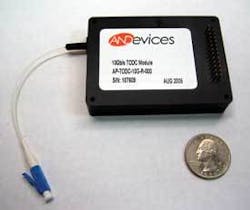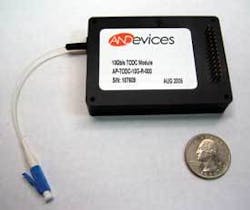TODC vendors ready inline and integrated devices
by Meghan Fuller
Tunable optical dispersion compensators (TODC) are used within 10- and 40-Gbit/sec optical systems to compensate for signal distortions caused by chromatic dispersion (CD). CD is a form of intersymbol interference (ISI), which is especially detrimental in optically amplified systems. CD causes a spreading of light pulses as they travel down an optical fiber. Different colors will propagate at slightly different speeds, thereby rendering the receiver unable to differentiate one light pulse from the next. TODCs work by introducing either positive or negative dispersion to balance or offset the dispersion in the fiber.The only TODCs deployed in significant numbers today are thermally tuned fiber Bragg grating (FBG)-based devices-and only at the receiver to combat residual dispersion. Sources interviewed for this article are unanimous in their assertion that TODCs have yet to be deployed for inline applications. And no integrated TODCs (i.e., within 300-pin MSA transponders) have been deployed to date. But TODC vendors are gearing up to offer such devices now.
There are two key applications for TODCs in the network: 1) residual compensation and 2) bulk or inline compensation (see figure). Residual compensation provides constant, per-channel dynamic adjustment at the receiver. It is necessary at data rates of 40 Gbits/sec and above, contends Christopher Doerr, distinguished member of the technical staff at Bell Labs (www.bell-labs.com). “If the link is long enough, say, 300 km, even environmental temperature changes in the fiber are enough to require a change in the TODC setting,” he notes.
Therefore, each wavelength needs a tunable dispersion compensator at 40 Gbits/sec. That said, “even though the tunable compensator is not used to compensate the dispersion on many channels at a time-it’s only a single channel at a time-the light still needs to be colorless, mainly for inventory purposes,” adds Martin Guy, vice president of product management and technology at TeraXion (www.teraxion.com).
Wenhua Lin, vice president of technology and new products at ANDevices (www.andevices.com), says she has seen some variation in the ways in which system vendors are deploying TODC technology for residual dispersion. “We see a lot of new applications where people are using the TODC combined with other things, like a transponder,” she confirms. “Usually, the TODC is a separate unit or line card before the receiver, but now system vendors want to integrate the TODC into the transponder.” While such integrated devices “are not really taking off right now,” Lin confirms that system vendors currently are weighing how to use TODC technology most efficiently in the network.
In today’s 10-Gbit/sec networks, a light signal can travel up to 65 km without dispersion compensation, reports Haim Laufer, senior vice president of sales and marketing for Civcom (www.civcom.com). Using chirp or a different modulation scheme extends that distance to 80 km, after which some form of inline dispersion compensation is required.
The sources interviewed for this story say that TODC is just starting to emerge as a replacement for the incumbent inline compensation technology-dispersion-compensating fiber (DCF)-for 10-Gbit/sec long-haul and metro systems. TODC for inline applications has not been used in the past for several reasons. First, the relatively recent emergence of reconfigurability places new requirements on the network in terms of tunability. Second, inline dispersion compensation is a bit more challenging than residual compensation, admits Bell Labs’ Doerr. “With inline, you need to be able to tolerate cascading effects,” he explains. Residual compensation, by contrast, “can have a smaller dispersion [window] because you only have to pass through once, and there’s no cascading.”
System vendors also may be slow to adopt TODC technology for inline applications because the incumbent DCF technology is so thoroughly entrenched. DCF is specialized fiber that has high levels of negative dispersion over relatively short lengths. While it is a widely used, proven technology, DCF is bulky, difficult to install, and suffers from high attenuation. The attenuation requires the use of additional amplification, which, in turn, adds to the overall cost of the system. Moreover, DCF is not tunable. “For each distance you have to compensate,” says Laufer, “you need a different product.”
TODCs, on the other hand, provide “set-and-forget” adjustment. “The big advantage is it’s easier for the customer to install a system because they don’t have to measure their link dispersion very accurately,” says Doerr. “Once [a TODC] is installed, they can tweak the amount of dispersion they’ll need.” Doerr also cites the advantage of tunability for inventory reduction; assuming they integrate the TODC component directly on a line card, system vendors could use the same card at every node.
Doerr confirms that Alcatel-Lucent is currently working to integrate TODCs for inline compensation into some of its commercially available products. While he recognizes that “the cost of tunable optical dispersion compensation has to come down for it to really be disruptive and take over inline,” Doerr believes the benefits of TODC outweigh the additional cost, even in the near term. He compares the use of TODC versus DCF to automatic versus standard transmission in a car. “Most drivers are willing to pay a bit more for automatic transmission,” he says, “because it is convenient and requires less training. It is the same with TODC versus DCF; with the proper feedback signal, TODC can automatically set the dispersion, whereas DCF requires skilled craft to install.”A further benefit of TODC technology is that the same device can be used for both residual and inline compensation, depending on where it is deployed in the network. “If it is placed near the optical amplifier, [the customer] probably wants to target it for DCF replacement,” says Lin. “If they use the TODC before the receiver, then they want to use it for residual dispersion compensation. But a single unit can do two functions.”
As TODC technology improves going forward, Doerr imagines that inline compensation could eventually eliminate the need for residual compensation. Such an implementation would be more cost-effective, he says, because you could eliminate the per-channel cost penalty of residual compensation.
Each vendor playing in the TODC market uses a different material technology and tuning mechanism; some are already commercially available, while others are still in development.
TeraXion claims to be the market leader in dispersion compensation with its FBG-based devices. TeraXion couples its FBG with a thermal gradient platform. “Basically, we change the thermal gradient on the fiber, and that changes the dispersion level,” says Guy. He notes that the same underlying technology is used for both TeraXion’s static or fixed dispersion compensators, which are widely deployed for both residual and inline compensation, and its tunable compensators. The vendor simply adds a tuning mechanism to the grating. “It’s a natural choice to move from a static dispersion compensator to a tunable dispersion compensator using a proven technology, which is the fiber Bragg grating,” he contends. TeraXion’s 10- and 40-Gbit/sec TODCs are commercially available.
While some cite the FBG’s size as a shortcoming-it is too large to be integrated into a 300-pin MSA transponder-Guy reports that TeraXion’s customers have not been asking for transponder-based devices. “I would say our customers are mainly integrating our components directly on their line cards,” he says.
TODCs also can be made from etalons, which are based on bulk optics made into an optical cavity that induces multiple beam interference between two mirrors. Etalons feature one of two tuning methods: They are either tuned by changing the space between the mirrors or by adjusting the temperature. Civcom’s etalon-based TODC, for example, is thermally controlled. Laufer reports that Civcom’s TODC is small enough to fit in a standard, 300-pin transponder. The vendor currently offers both the dispersion compensation component as well as the component integrated within a 300-pin transponder, enabling system vendors to achieve distances between 170 and 350 km, says Laufer.
Fujitsu (www.fujitsu.com), meanwhile, has commercially available 10- and 40-Gbit/sec dispersion compensators based on virtual image phased array (VIPA) technology. In a VIPA-based device, dispersion compensation is accomplished via a thin glass plate coated on both sides with a reflecting film and a reflecting mirror. Industry insiders report that such devices achieve the largest dispersion of any TODC to date but currently have a large footprint and high insertion loss.
ANDevices employs a planar lightwave circuit (PLC) approach in which a cascade of multiple Mach-Zehnder interferometers (MZIs) is integrated into a single chip. When a voltage is applied to tune the phases, light with different wavelengths travels through two MZI arms separately, resulting in negative and positive dispersion. According to Lin, the same design can be used for single- or multiple-channel TODCs. She says ANDevices chose the PLC design to leverage the material’s mass- reproducible semiconductor fabrication techniques, thus lowering costs. Moreover, it features no moving parts and can be easily integrated with other devices, she says. The company is currently shipping prototype 10- and 40-Gbit/sec TODCs.
Bell Labs also employs PLC technology in the form of silica arrayed waveguide gratings (AWGs). According to Doerr, Bell Labs uses a high-resolution AWG along with a polymer-based thermo-optic lens that it developed in collaboration with Gemfire Corp. (www.gemfirecorp.com). “To get dispersion, you need a linear group delay, which means you need a parabolic phase distribution,” he explains. “The high-resolution AWG spreads the spectrum across the thermo-optic lens, and the thermo-optic lens gives you a parabolic phase. You have a region of the material, and you heat up, let’s say, the center more than the edges, creating the parabolic phase.” The polymer is useful, he says, because it creates a large index change over temperature.
Besides DCF, all flavors of TODCs also will compete against electronic dispersion compensation (EDC), at least at 10 Gbits/sec. EDC is performed after the optical-electrical-optical conversion and may be accomplished via adaptive clock and data recovery or adaptive equalization. EDC is not yet commercially available at 40 Gbits/sec.
Some industry insiders wonder if perhaps EDC will find its niche as a complementary technology to TODC, which only compensates for chromatic dispersion. EDC can be used to combat polarization-mode dispersion, which is problematic for higher-bit-rate systems. Several sources interviewed for this story note that a hybrid implementation of both ODC and EDC may be the best option. In fact, says Doerr, EDC can be used to clean up the high-order effects (e.g., group delay ripple) introduced by the TODC devices themselves. “I think in the future, we’ll see a combination of EDC and ODC,” he maintains.Meghan Fuller is senior editor at Lightwave.


